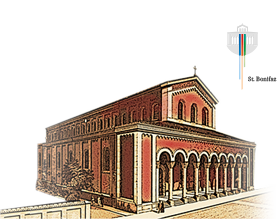- Product range
- History
- Raw materials & brewing process
- Distribution & sales
- Guided Tours
- EMAS environmental certification
- Beer glossary
- Andechs Beer in US
Nothing ferments without yeast
When the Bavarian purity law was passed in 1516, nobody knew about brewer’s yeast.
Its effects have been known since the 17th century, but it was not until about 200 years later that Louis Pasteur found out that tiny organisms – yeasts – are involved in fermentation. Until then, bakers in some communities were considered ingenious but also somewhat suspicious beer artists.
Accompany the yeast on its way through the fermentation process.
The ancient Germanic peoples were convinced that Wotan’s spit was at work in beer fermentation. But our ancestors failed in attempts to produce this spit themselves. The English settled on the explanation that beer ferments thanks to the benevolence of God. The Swiss took a different view and simply held beer witches responsible for the entire fermentation process. It was also widely believed for a long time that honey caused beer to ferment.
Why bakers used to be considered the best brewers.
Bakers – beer artists or magicians? A conservative estimate is that, in medieval times, no more than two out of ten attempts at brewing beer were successful. Attempts were made to induce fermentation using what seem like very dubious means today. Ox gall, saffron or ammonium carbonate were not the only additives, and from today’s perspective not even the least appetizing. Bakers on the other hand appeared to have little difficulty with fermentation. They happily got on with brewing and their beers just worked. So well, in fact, that brewing rights were often and gladly given to bakers. However, bakers were accused time and time again of being sorcerers, magicians or even in league with the devil.
There was no knowledge of microorganisms at the time. Therefore, what they can use as nutrients and what is ultimately produced as the end product of their metabolism was not clear either. Alcohol was produced by “spontaneous fermentation”. Certain microorganisms were able to propagate depending on the ambient conditions. Bakers were simply fortunate to have the right yeast cultures in their bakeries.
From the purity law to the pure yeast culture
Even today, millions upon millions of microscopic yeast cells capable of producing a good beer are floating around in every bakery. But brewer’s yeast was as yet unknown when the Bavarian purity law was passed by Duke Wilhelm IV in 1516. While its effectiveness was recognised around one hundred years later, one previously spoke of fortune or chance when the wort actually began to ferment.
With knowledge about the effects of yeast, targeted top-fermented or bottom-fermented brewing commenced in the 17th century. Using specific strains of microorganisms for the production of alcoholic beverages only became possible after their discovery and systematic research. Louis Pasteur (1822-1895), the famous French natural scientists and, alongside Robert Koch, one of the founders of microbiology, discovered in the mid-19th century that tiny organisms are involved in fermentation: yeasts. They are microscopic single-celled organisms from the family of yeast-like fungi. Yeast works with enzymes, which are already familiar from malting (see the article on malt).
The Danish botanist Emil Christian Hansen (1842-1909) ultimately found out that yeasts include multiple fungus organisms, and that specific strains can be cultivated in pure cultures. This discovery laid the foundation for the wealth of yeast strains available to master brewers today, which cause the beer to ferment and have a crucial impact on its taste.
Yeast – a brief character sketch
Systematically yeast is classified as a fungus. What we call brewer’s yeast belongs to the genus Saccharomyces. The various strains of this genus differ in their fermentation capacity and their metabolic products. Top-fermenting and bottom-fermenting yeasts are used in the brewery.
Propagation by budding is typical for brewer’s yeast. During budding, a bud forms on the cell, develops into a complete yeast cell and then separates. The original cell is thereby cloned. Resulting cells have exactly the same characteristics. However, sexual reproduction by means of spore formation is possible as well. This does mean that the cell’s genetic makeup is rewritten and different – including unwanted – yeast characteristics can develop. In what is known as yeast management, the master brewer has to maintain ideal conditions to optimise the fermentation properties of the yeast.
Where the monastery brewery uses yeast
Naturally, new yeast is not needed for every brew in the brewing process. Yeast propagates on its own during brewing. Fresh pure yeast culture is always added as well. The master brewer calls this “pitching”. At the end of the fermentation process, the brewer – depending on the type of beer – can draw off about three times as much yeast as was originally added to the wort at the start of the fermentation process. This is because the wort contains all of the nutrients required for propagation, such as proteins, carbohydrates, trace elements and vitamins, and also oxygen.
What the yeast does
After cooling, the wort is pumped from the brewhouse into the respective tanks in the fermentation cellar. It is the master brewer’s art to pitch the right amount of yeast so the yeast cells stop their activity “at the right time” to obtain the desired fermentation result and taste. This result can be obtained by coordinating various factors, such as:
- A certain composition of the wort, i.e. the type and amount of sugar and amino acids as well as the ratio between them
- Targeted aeration of the wort with oxygen when pitching the yeast
- Using a specific yeast strain in the corresponding quantity
- Exact control of the temperature during and towards the end of fermentation
- Possibly pressure on the fermentation tank
After pitching, the wort and yeast become highly active. The yeast turns malt sugar into alcohol and carbon dioxide. Here is what happens in detail: Aside from simple sugars such as glucose and fructose, the yeast mainly has maltose available in the wort. Glucose and fructose enter the yeast cell without assistance. Maltose is actively transported into it. Inside the cell, a chemical process turns the sugar as the starting material into alcohol and carbon dioxide as the end products. The cell also obtains energy from the process.
The propagation of the yeast during fermentation can be roughly divided into three phases: During the first “latent” phase, there is no propagation. In the second “logarithmic” phase, the yeast grows exponentially. In the third “lethal” phase, the propagation of the yeast slows down continuously due to the lack of oxygen and the rising concentration of alcohol and carbon dioxide.
Bottom-fermenting brewer’s yeast ferments best at temperatures below 10 °C and increasingly settles at the bottom of the fermentation tank as fermentation progresses. Top-fermenting brewer’s yeast ferments best at temperatures around 20 °C. During budding as described above, the mother and daughter cells do not separate completely. Branching chains of cells (called “krausen”) form as a result and rise to the top with the carbon dioxide during fermentation.
As the alcohol content in the beer increases during this process, the malt sugar content decreases. The master brewer maintains a constant overview of this process with the hydrometer. After a specific number of days – precisely established in the monastery brewery’s recipes depending on the type of beer – the main fermentation ends with a predetermined alcohol content of the “green beer”.
Depending on the type of beer, the yeast is used for multiple brews in a row. Until the next fermentation process, the yeast is washed with clear brewing water, cleaned and stored in special yeast tanks at temperatures close to the freezing point. The Andechs Monastery brewery also grows its own yeast cultures in specially designed containers.




